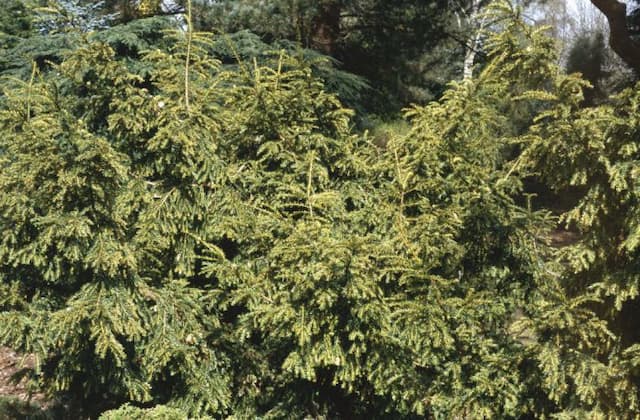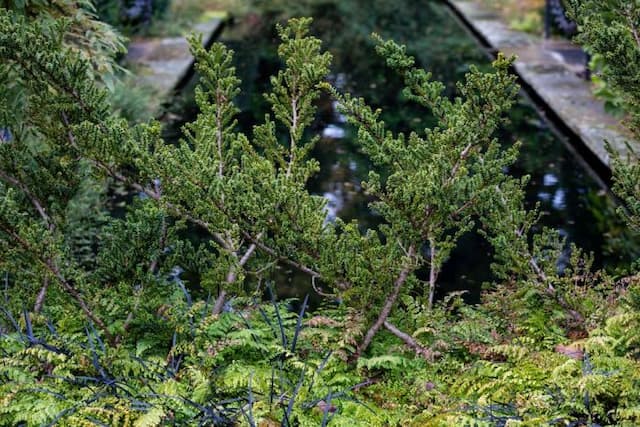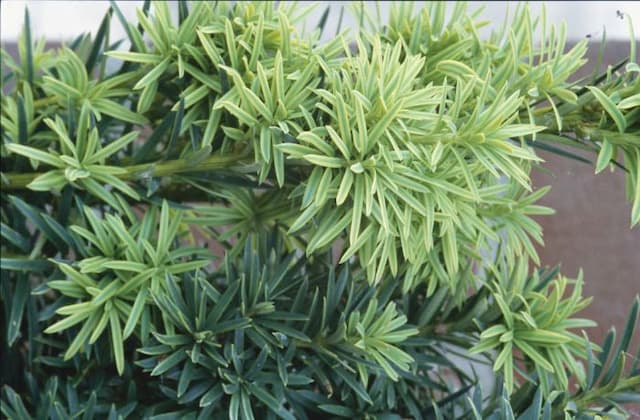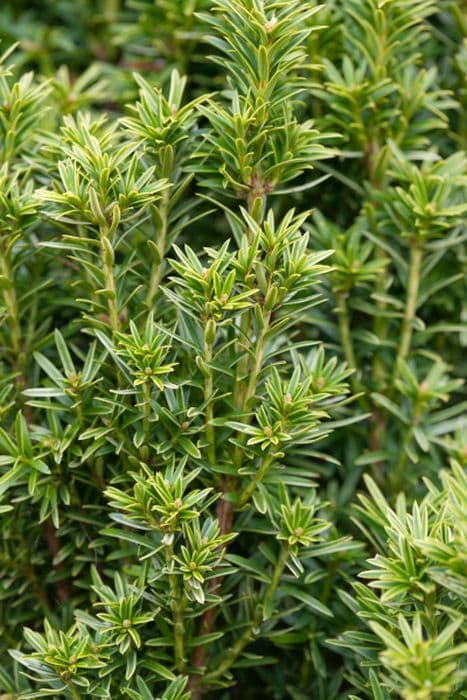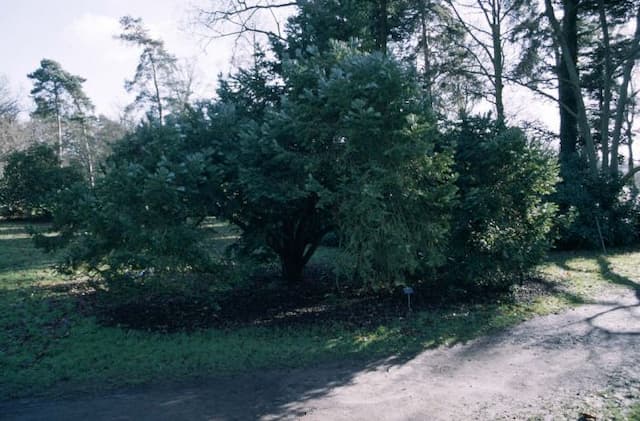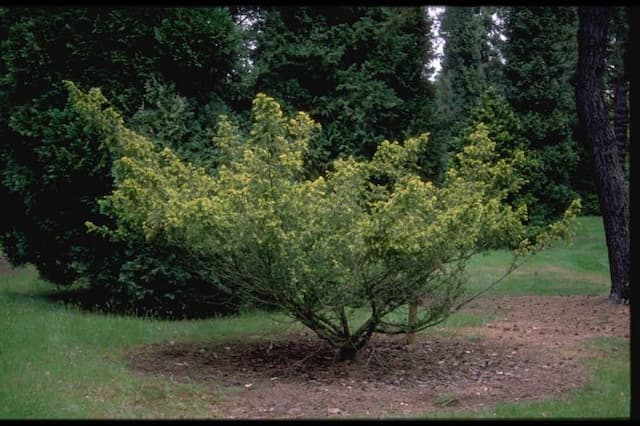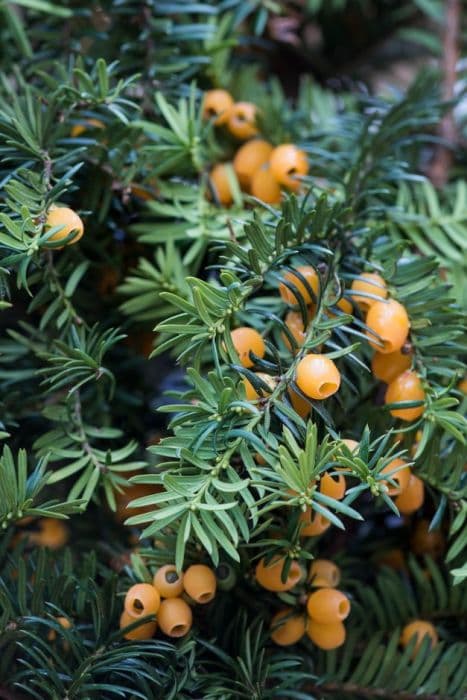Taxus baccata Fastigiata Aurea Group
ABOUT
The plant known as the Irish Yew is a distinctive evergreen with a naturally upright and columnar growth habit, making it an attractive addition to gardens and landscapes. The Irish Yew is characterized by its striking foliage, which is a combination of dark green and golden-yellow needles. The yellow coloring is more prominent on the leaves that receive full sunlight, giving the plant a vibrant, variegated look, and this golden tinge is especially eye-catching when set against the darker green of the shaded foliage. The needles of the Irish Yew are small, narrow, and spiral around the branches, which grow densely to create a tight, compact form. This display of colorful foliage persists throughout the year, adding year-round interest to the plant's surroundings. Moreover, the Irish Yew may produce conspicuous, bright red berry-like structures that are actually modified cones with a fleshy covering. These are typically more prominent on female plants. The contrast between the red of these berry-like structures and the golden-green foliage further enhances the Irish Yew's ornamental appeal. Overall, the Irish Yew's unique coloration and tidy growth habit makes it a popular choice for hedges, topiary, and as a specimen in gardens.
About this plant
 Names
NamesFamily
Taxaceae
Synonyms
Golden Irish Yew, Aurea Fastigiata Yew, English Yew
Common names
Taxus baccata Fastigiata Aurea Group.
 Characteristics
CharacteristicsLife cycle
Perennials
Foliage type
Evergreen
Color of leaves
Green
Height
10 15 (3 4.57)
Spread
2 3 (0.61 0.91)
Plant type
Shrub
Hardiness zones
7
Native area
Europe
Benefits
 General Benefits
General Benefits- Ornamental Value: Taxus baccata Fastigiata Aurea Group, commonly known as the Golden Irish Yew, has distinct golden-yellow foliage that adds visual interest and aesthetic appeal to landscapes and gardens.
- Ease of Shaping: This plant is amenable to pruning and shaping, which makes it a good choice for creating hedges, topiaries, or other formal garden structures.
- Drought Tolerance: Once established, Golden Irish Yew is relatively drought-tolerant, requiring less watering compared to many other garden plants, which can lead to water conservation.
- Shade Tolerance: It can grow in a range of light conditions, from full sun to shade, providing landscaping options for various garden situations.
- Longevity: Yews are known for their long lifespan. The Golden Irish Yew can thrive for many years, making it a long-term addition to any garden.
- Wildlife Support: Although the berries are toxic to humans, they can provide food for certain bird species during the winter months.
- Low Maintenance: Since it is slow-growing and adaptable, the Golden Irish Yew generally requires minimal upkeep beyond occasional pruning and standard care.
- Soil Adaptability: It can tolerate a variety of soil types, including chalky, loamy, or sandy soils, provided they are well-drained.
- Resistance to Pests and Diseases: The Golden Irish Yew has a natural resilience to many common pests and diseases that affect other garden plants.
- Year-Round Interest: With evergreen foliage, the Golden Irish Yew maintains its color and structure throughout all seasons, providing year-round interest in the garden.
 Medical Properties
Medical Properties- This plant is not used for medical purposes.
 Air-purifying Qualities
Air-purifying QualitiesThis plant is not specifically known for air purifying qualities.
 Other Uses
Other Uses- Woodworking and Crafting: The wood of the English yew is very hard and durable, making it ideal for creating detailed wooden crafts such as chess pieces and intricate carvings.
- Aquarium Decoration: After proper treatment to remove any harmful substances, branches of the English yew can be used as natural-looking decorations in aquariums.
- Dye Production: The bark and needles of the English yew can be used to produce natural dyes for textiles, yielding shades of brown or green.
- Garden Sculptures: The dense foliage and unique color can be shaped into living sculptures or topiaries in ornamental gardens.
- Privacy Screens: Taller varieties of the English yew can be strategically planted to create natural privacy screens for outdoor spaces.
- Sound Barrier: Planted in rows, yew hedges can help reduce noise pollution from roads or neighbors.
- Windbreaks: The English yew can be grown as windbreaks to protect more fragile plants and reduce soil erosion in gardens.
- Archery Bows: Historically, the dense and elastic wood was prized for making longbows, although this is less common today.
- Photography Backdrops: The richly colored foliage can serve as a lush backdrop for outdoor portrait photography.
- Bonsai: With its ability to withstand pruning and training, the English yew is occasionally used in the art of bonsai for creating miniature landscapes.
Interesting Facts
 Feng Shui
Feng ShuiThe Irish Yew is not used in Feng Shui practice.
 Zodiac Sign Compitability
Zodiac Sign CompitabilityThe Irish Yew is not used in astrology practice.
 Plant Symbolism
Plant Symbolism- Longevity: The Taxus baccata, commonly known as the Yew tree, is often associated with longevity due to its capacity to live for hundreds, sometimes even thousands, of years.
- Death and Rebirth: In some cultures, yew trees symbolize death and rebirth as they have toxic parts and yet provide shelter and are evergreen, representing enduring life.
- Immortality: The evergreen nature of yew trees also denotes immortality, as they stay green year-round and appear to defy the typical life cycle of plants.
- Transformation: Yew trees are linked with transformation because they can easily regenerate by sprouting from cut stumps or fallen branches.
 Water
WaterThe Golden Irish Yew should be watered regularly, aiming to keep the soil moist but not waterlogged. During the growing season, typically spring and summer, water the plant about once a week with one to two gallons, depending on the weather conditions and soil drainage. In the fall and winter, reduce watering to every two to three weeks, depending on rainfall and temperature, providing the same amount of water. Always check the top inch of soil for dryness before watering to prevent overwatering.
 Light
LightGolden Irish Yew prefers to be in a location with full sun to partial shade. The ideal spot for this evergreen conifer is one that receives morning sunlight and some afternoon shade or dappled light throughout the day. Avoid deep shade as it may hinder growth and affect the vibrancy of the foliage.
 Temperature
TemperatureThe Golden Irish Yew thrives in a wide range of temperatures, withstanding lows down to about -20 degrees Fahrenheit and with an ideal growing temperature range between 60 to 70 degrees Fahrenheit. It can tolerate high temperatures as well, but it's important to ensure good soil moisture during hot weather to avoid stress on the plant.
 Pruning
PruningPrune Golden Irish Yew to shape and maintain its size or to remove damaged or diseased branches. The best time for pruning is in late winter or early spring before new growth starts. They can be pruned annually, but light pruning every few years is also sufficient for maintaining a good shape, as they are slow-growing plants.
 Cleaning
CleaningAs needed
 Soil
SoilThe Golden Irish Yew prefers well-drained, sandy loam soil with a pH range of 6.0 to 7.5. A suitable soil mix can be created using two parts loam, one part peat or leaf mold, and one part sharp sand or perlite to ensure proper drainage and aeration.
 Repotting
RepottingGolden Irish Yew should be repotted every few years as it is a slow grower. It is best to repot only when the plant has outgrown its current pot, which may be every 3 to 5 years.
 Humidity & Misting
Humidity & MistingGolden Irish Yew thrives in outdoor environments and does not require specific humidity levels. It tolerates a wide range of outdoor humidity conditions as long as it is not in consistently wet soil.
 Suitable locations
Suitable locationsIndoor
Grow Golden Irish Yew in bright, indirect light with good air circulation.
Outdoor
Plant Golden Irish Yew in sun to partial shade with well-drained soil.
Hardiness zone
6-8 USDA
 Life cycle
Life cycleThe common name for Taxus baccata Fastigiata Aurea Group is the Golden Irish Yew. The life cycle begins with seed germination, where the seeds, often dispersed by birds, germinate in favorable conditions of moisture and light. After germination, the seedling stage follows, where roots and shoots develop to form a small plant. As the plant matures, it enters the vegetative growth stage, developing its characteristic narrow, columnar shape and golden-yellow foliage, and can grow quite slowly. Once reaching maturity, which can take several years, the Golden Irish Yew produces red, cup-shaped seed cones and small, shield-shaped pollen cones for reproduction, which are key indicators of the reproductive stage. Lastly, as an evergreen, this plant maintains its foliage throughout the year until the end of its lifespan, which can extend to several hundred years under ideal conditions.
 Propogation
PropogationPropogation time
Early Spring
Propogation: The most popular method for propagating the Taxus baccata Fastigiata Aurea Group, commonly known as the Golden Irish Yew, is through cuttings. This is typically done in late summer. To propagate, semi-ripe cuttings of about 4-6 inches (10-15 centimeters) are taken from the current year’s growth. The lower needles are removed, and the cut end of the cutting is dipped in rooting hormone to encourage root growth. Then, the cutting is placed in a well-draining soil mixture. The cuttings are kept under a light mist to maintain high humidity levels and prevent drying out, which is essential for successful rooting. It can take several months for the cuttings to root fully, so patience is key.
